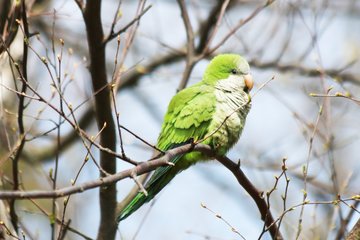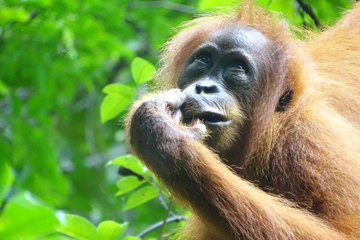Female bonobos start up early
Onset of puberty in female bonobos precedes that of chimpanzees
Puberty is the threshold between childhood and adulthood. Behavior and appearance change considerably during this period – not only in humans but also in our closest relatives, the great apes. In a current study researchers of the Max Planck Institute for Evolutionary Anthropology in Leipzig, Germany, have investigated at which age bonobos and chimpanzees, the closest living relatives of humans, enter puberty. In order to determine the onset of puberty the researchers measured the concentration of the hormone testosterone which rapidly increases when male and female primates reach sexual maturity. They found that in males of both species urinary testosterone levels increase at an age of about eight years. Female chimpanzees showed a similar increase at a slightly older age. Female bonobos, however, were found to enter puberty already with five years of age. This is surprising since bonobos are known to be late bloomers whose developmental processes tend to be delayed or take longer in comparison to chimpanzees.

During puberty, rising hormone levels stimulate somatic growth and the development of secondary sex characteristics, and the child becomes a grown-up individual. The timing of puberty depends, among others, on environmental conditions, nutrition and social factors. From a biological point of view puberty is the starting signal for the race of passing on one’s own genes to future generations. While pubertal changes in humans and male chimpanzees have been well investigated, this has not been the case so far for bonobos and female chimpanzees.
In their current study researchers of the Max Planck Institute for Evolutionary Anthropology in Leipzig, Germany, have measured the concentrations of testosterone in the urine of 42 male and 97 female chimpanzees and of 48 male and 64 female bonobos. They found that female bonobos enter puberty around three years earlier than female chimpanzees and males of both species. “Given the early onset of puberty, one would predict to assume that female bonobos give birth to their first child earlier than chimpanzees. Yet, this does not seem to be the case“, says Verena Behringer, researcher at the Max Planck Institute for Evolutionary Anthropology and first author of the study.
In contrast to most other primates, young female chimpanzees and bonobos leave their birth group when they reach sexual maturity. Entering a novel range and exposure to an unfamiliar social environment bears high potential costs for the young female. Especially in chimpanzees this is not always easy because food is limited and each additional group member’s needs may raise competition. The social pressure is partially compensated by the fact that young females become more attractive to males. This motivates chimpanzee males to protect female newcomers against the aggressive behavior of other female group members.
In bonobos, female teenagers start their search for a new group between two and three years earlier than female chimpanzees. In contrast to them, female bonobos joining a new community encounter curiosity rather than aggression. “Possible advantages from entering puberty earlier are a greater search area for a new group and more time to obtain social experiences and to develop their sexuality”, says Verena Behringer. “The latter is a central element in the behavioral repertoire of bonobos which helps to solve conflicts, and establish friendly relations with others.”
The urine samples used for this study came from apes living in zoos. Therefore, the nutritional status can be excluded as a reason for the time discrepancy between both species. “The earlier onset of puberty in bonobos seems to be a characteristic feature that emerged during the evolutionary development of both sister species“, says Verena Behringer.
VB, GH, SJ/HR












